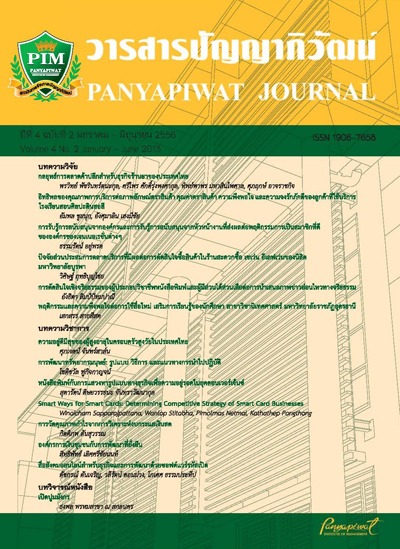การพัฒนาทรัพยากรมนุษย์: รูปแบบ วิธีการ และแนวทางการนำไปปฏิบัติ
Main Article Content
บทคัดย่อ
การพัฒนาทรัพยากรมนุษย์สามารถแบ่งได้เป็นสามรูปแบบ ได้แก่ การศึกษา การฝึกอบรม และการสนับสนุน การศึกษา คือ การมุ่งพัฒนาทรัพยากรมนุษย์เพื่อการดำเนินชีวิต และเตรียมพร้อมสำหรับการปฏิบัติงาน เช่น การศึกษาในระบบ การศึกษานอกระบบ การศึกษาตามอัธยาศัย เป็นต้น ส่วนการฝึกอบรม คือ การพัฒนาทรัพยากรมนุษย์เพื่อเพิ่มศักยภาพในการปฏิบัติงาน เช่น การบรรยาย การระดมสมอง การสาธิต ฯลฯ และการสนับสนุน คือ การพัฒนาทรัพยากรมนุษย์เพื่อเพิ่มศักยภาพเฉพาะบุคคลในการปฏิบัติงาน เช่น การสอนงาน การหมุนเวียนงาน การใช้แนวทางชุมชนนักปฏิบัติ เป็นต้น การศึกษาจึงมีขอบข่ายที่กว้างกว่าการฝึกอบรม และการฝึกอบรมจะมีขอบข่ายที่กว้างกว่าการสนับสนุน อย่างไรก็ตามทั้งสามรูปแบบสามารถนำมาพัฒนาศักยภาพของมนุษย์ได้ทั้งแปดด้าน ได้แก่ ด้านศาสนา ด้านสุขภาพ ด้านสติปัญญา ด้านความรู้ ด้านทักษะ ด้านเจตคติ ด้านประสบการณ์ และด้านบุคลิกภาพ ส่วนขั้นตอนในการพัฒนานั้นควรเริ่มจากการประเมินความจำเป็น การวางแผน การเตรียมการ การดำเนินการพัฒนา และการประเมินผลการดำเนินการพัฒนา และการประเมินผลการปฏิบัติงานหลังจากการพัฒนาทั้งในเชิงประสิทธิภาพ และประสิทธิผล
There are three kinds of human resource development covering education, training, and supporting. The purpose of education is to develop human resources to be ready for their living and working such as formal education, non-formal education, informal education, etc. Training is designed to develop the capacity of human resources in their work, for example lecture, brainstorming, demonstration, etc., whereas supporting is intended to increase personal capacity such as coaching, job rotation, community of practice, etc. Therefore, education has wider ranges than training. At the same time, training has wider scopes than supporting. However, all three types are designed to develop human potentials in eight aspects: religion, health, intelligence, knowledge, skills, attitude, experience, and personality. The process of development should start from need assessment. Later, planning, preparation, and implementation will be done. Lastly, evaluating the results of development and implementation will be conducted both in terms of efficiency and effectiveness to provide further improvement
Article Details
“ข้าพเจ้าและผู้เขียนร่วม (ถ้ามี) ขอรับรองว่า บทความที่เสนอมานี้ยังไม่เคยได้รับการตีพิมพ์และไม่ได้อยู่ระหว่างกระบวนการพิจารณาลงตีพิมพ์ในวารสารหรือแหล่งเผยแพร่อื่นใด ข้าพเจ้าและผู้เขียนร่วมยอมรับหลักเกณฑ์การพิจารณาต้นฉบับ ทั้งยินยอมให้กองบรรณาธิการมีสิทธิ์พิจารณาและตรวจแก้ต้นฉบับได้ตามที่เห็นสมควร พร้อมนี้ขอมอบลิขสิทธิ์บทความที่ได้รับการตีพิมพ์ให้แก่สถาบันการจัดการปัญญาภิวัฒน์หากมีการฟ้องร้องเรื่องการละเมิดลิขสิทธิ์เกี่ยวกับภาพ กราฟ ข้อความส่วนใดส่วนหนึ่งและ/หรือข้อคิดเห็นที่ปรากฏในบทความข้าพเจ้าและผู้เขียนร่วมยินยอมรับผิดชอบแต่เพียงฝ่ายเดียว”
References
Gilley, J. W., Eggland, S. A., & Gilley, A. M. (2002). Principles of human resource development.2nd ed. Cambridge: Perseus.
Nadler, L. (1990). Human resource development. pp. 1.1-1.47. In L. Nadler & Z. Nadler, eds.The handbook of human resource development. 2nd ed. New York: John Wiley & Sons.
Swanson, R. A., & Holton, E. F. (2001). Foundations of human resource development. San Francisco: Berrett-Koehler.
Swart, J., Mann, C., Brown, S., & Price, A. (2005). Human resource development: Strategy and tactics. Chennai: Charon Tec Pvt.
Walton, J. (1999). Strategic human resource development. London: Financial Times Management.
Yorks, L. (2005). Strategic human resource development. Mason, OH: South Western Thomson.

